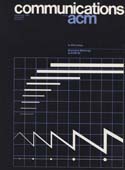September 1980 - Vol. 23 No. 9

Features
Moving to a new system is costly and error-prone. The problem can be reduced through use of a virtual operating system that disentangles computing environments from their underlying operating systems. The authors report on their successful experience in doing this and achieving inter-system uniformity at all three levels of user interface: virtual machine, utilities, and command language.
An overrelaxation for a numerical inverse of a constant
When division is performed by a power series implementation with additions, subtractions, digit shifts, and multiplications, the convergence rate of the power series is important in practical application. Particularly if the rate of the power series is close to one, the convergence is slow and therefore a special method to accelerate the convergence is needed. Without such an acceleration, the power series implementation is less attractive. An acceleration method is proposed for the slow convergence rate. First, the worst case convergence rate of the power series is determined for a given appropriate acceleration factor. Next, a simple way to choose the appropriate acceleration factor is presented.
Computer system design using a hierarchical approach to performance evaluation
The concept of a hierarchy of performance models is introduced. It is argued that such a hierarchy should consist of models spanning a wide range of accuracy and cost in order to be a cost-effective tool in the design of computer systems. Judicious use of the hierarchy can satisfy the conflicting needs of high accuracy and low cost of performance evaluation. A system design procedure that uses the hierarchy is developed.
The concepts developed are illustrated by applying them to a case study of system design. The results of optimizations conducted using a two-level performance model hierarchy and a simple cost model are discussed. In almost all the experiments conducted, the optimization procedure converged to a region very close to a locally optimum system. The efficiency of the procedure is shown to be considerably greater than that of the brute force approach to system design.
Partial-match retrieval using indexed descriptor files
In this paper we describe a practical method of partial-match retrieval in very large data files. A binary code word, called a descriptor, is associated with each record of the file. These record descriptors are then used to form a derived descriptor for a block of several records, which will serve as an index for the block as a whole; hence, the name “indexed descriptor files.”
First the structure of these files is described and a simple, efficient retrieval algorithm is presented. Then its expected behavior, in terms of storage accesses, is analyzed in detail. Two different file creation procedures are sketched, and a number of ways in which the file organization can be “tuned” to a particular application are suggested.



